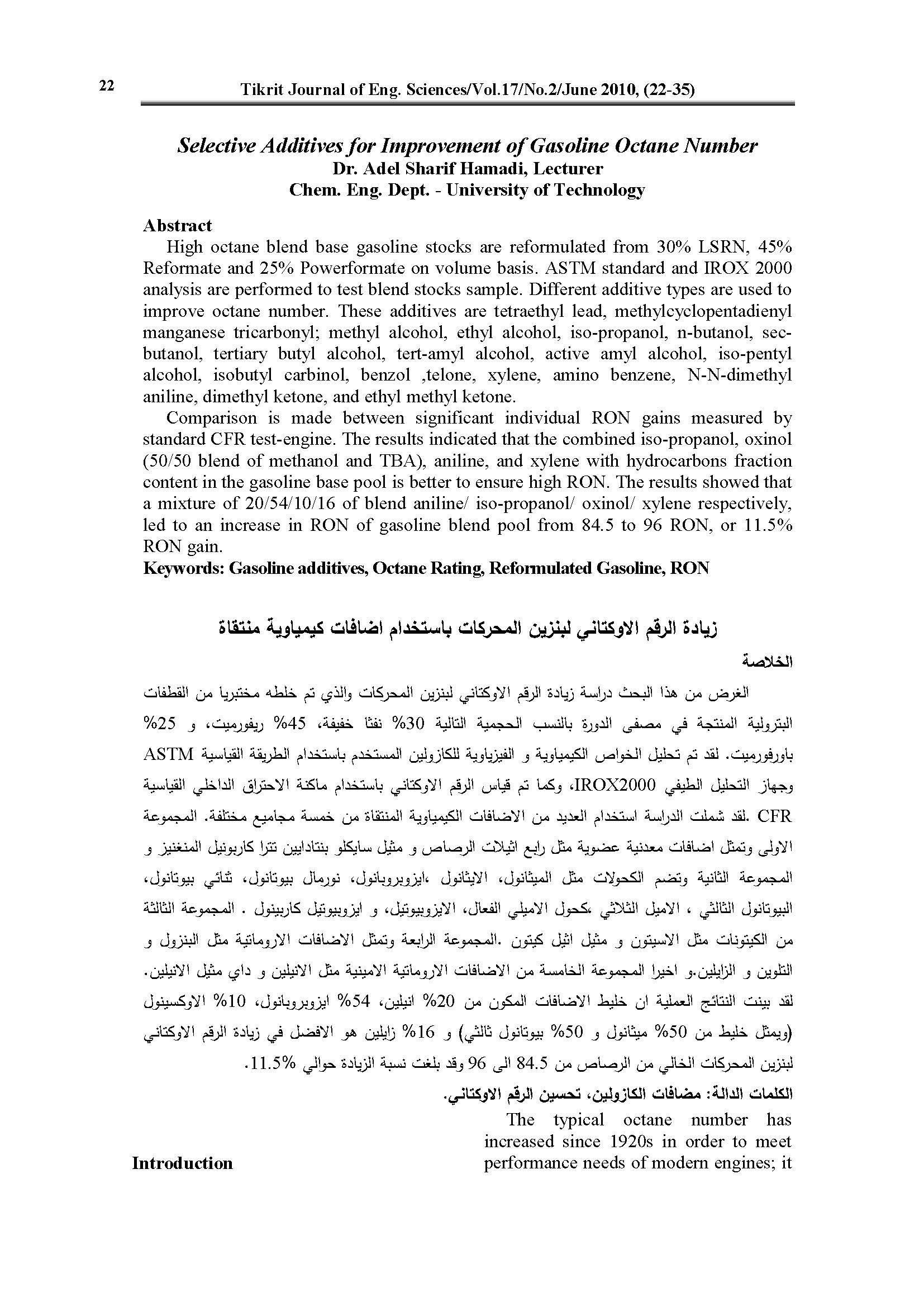Selective Additives for Improvement of Gasoline Octane Number
Main Article Content
Abstract
High octane blend base gasoline stocks are reformulated from 30% LSRN, 45% Reformate and 25% Powerformate on volume basis. ASTM standard and IROX 2000 analysis are performed to test blend stocks sample. Different additive types are used to improve octane number. These additives are tetraethyl lead, methylcyclopentadienyl manganese tricarbonyl; methyl alcohol, ethyl alcohol, iso-propanol, n-butanol, sec-butanol, tertiary butyl alcohol, tert-amyl alcohol, active amyl alcohol, iso-pentyl alcohol, isobutyl carbinol, benzol ,telone, xylene, amino benzene, N-N-dimethyl aniline, dimethyl ketone, and ethyl methyl ketone. Comparison is made between significant individual RON gains measured by standard CFR test-engine. The results indicated that the combined iso-propanol, oxinol (50/50 blend of methanol and TBA), aniline, and xylene with hydrocarbons fraction content in the gasoline base pool is better to ensure high RON. The results showed that a mixture of 20/54/10/16 of blend aniline/ iso-propanol/ oxinol/ xylene respectively, led to an increase in RON of gasoline blend pool from 84.5 to 96 RON, or 11.5% RON gain.
Metrics
Article Details

This work is licensed under a Creative Commons Attribution 4.0 International License.
THIS IS AN OPEN ACCESS ARTICLE UNDER THE CC BY LICENSE http://creativecommons.org/licenses/by/4.0/
Plaudit
References
Strikkers, D.E., Octane and the environment, The Science of the Total Environment, 299, pp. 37-56, 2002. DOI: https://doi.org/10.1016/S0048-9697(02)00271-1
Maples, R.E., Process Refinery Process Economics. Penn Well Books, Tulsa, Oklahoma, p.25, 1993.
Caris, D. F. and Nelson, E. E. A New Look at High Compression Engines SAE Trans. 1959. DOI: https://doi.org/10.4271/590015
Getting the Lead Out” Chapter 10 in Bill Bryson “A Short History of Nearly Everything” Broadway Books: New York, 2003.
Gary, J.H. and Handwerk, G.E., .Petroleum Refining Technology and Economics, 2nd Edition”, Marcel Dekker, New York, pp 199, 1984.
Westbrook, C.K. Pitz. W.J., The Chemical Kinetics of Engine Knock. Energy and Technology Review, p.1-13., Feb/Mar 1991.
Knock .C.K., The Chemistry behind Engine, Westbrook Chemistry & Industry (UK), pp.562-566, 3 August 1992.
Seyferth, D., “The Rise and Fall of Tetraethyllead. 2″, Organometallics, vol. 22, pp 5154-5178, 2003. DOI: https://doi.org/10.1021/om030621b
Versloot, j. polytech., vol. 34, №. 8, pp. 479-483 , 1979 DOI: https://doi.org/10.1111/j.1541-0072.1979.tb01255.x
Gallagher, R.S., Gallagher, M.F. Wyatt, Jacksonville, FL, Technical Paper Introduction to Ecotane methylcyclopentadiene manganese tricarbonyl) Research Staff T2 Laboratories Inc., Supersedes: None T2 laboratories Inc. Research & Analytical Services, Revised: 4 Jul 2006
RMIT “Desk Study Octane Enhancers”, November 1994.
Rasskazchikova, T. V. Kapustin, V. M. and Karpov, S. A. Khim. Tekhnol. Topl. Masel, No. 4, 3-7 (2004).
Onoichenko, S. N. Use of Oxygenates in Production of Future Automotive Gasolines [in Russian], Tekhnika, pp. 5, 2003.
Patel, K.S., Kuma, S. and Kwo, O.Y. The Performance Characteristics of Indolene-MPHA Blends in a Spark Ignition Engine”, SAE 872069.
Sposini, M., Pea, R. et al., Proceedings of the Fifth International Alcohol Fuel Technology Symposium, Vol. II, 1982.
“Alcohols and Ethers A Technical Assessment of Their Application as Fuels and Fuel Components”, API Pub. 4261, 2nd Edition, 1988.
Dupont De Nemours E.I. and Company, Inc., “Clean Air Act Waiver Application Section 211(f)”, Application to the US. Environmental Protection Agency, Vol. 3, Sect. XIII, 1984.
Furey, R.L. “Volatility Characteristics of Gasoline-Alcohol and Gasoline-Ether Fuel Blends”, SAE 852116.
Owen K. and Coley, T. “Automotive Fuels Reference Book”, Second Edition, Society of Automotive Engineers, Inc., 1995.
Shota Atsumi1, Taizo Hanai1 & James C. Liao1, “Non-fermentative pathways for synthesis of branched-chain higher alcohols as biofuels “,Nature 451, pp. 86-89 (3 January 2008) DOI: https://doi.org/10.1038/nature06450
Patel, K. S. Kuma, S. and Kwo, O.Y.” The Performance Characteristics of Indolene-MPHA Blends in a Spark Ignition Engine”, SAE 872069
Jin, M. Yu, Z. and Xia, Y. electrochemical and specroelectro-chemical studies on electro-chemistry, vol. 42, no. 9, pp. 964-968, 2006. DOI: https://doi.org/10.1134/S1023193506090096





